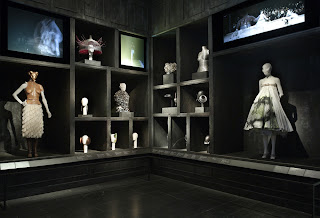"For me, what I do is an artistic expression which is channeled through me. Fashion is just the medium."
-Alexander McQueen
During the scorching summer months of May through July, the world was in a frenzy over the late, Alexander McQueen's final exhibition, Savage Beauty, at The Metropolitan Museum of Art (The Met) in NYC, revealing an extensive look into his artistic creations he deemed as fashion. The wait was over three hours but as an artoholic, leaving was not an option.
The signage inside The Met, warning of a two-hour wait to the exhibit.
They weren't joshing us!
Offering a retrospective of his works from 1992 until his untimely, tragic and suicidal death at the tender age of 40, in February of 2010, the exhibition unveiled a world of runways filled with theatrics and romance of utter ethereal beauty that bridged art with high-end couture. His visions of Romanticism, the Gothic, Nationalism, Exoticism, Primitivism and Naturalism were transcended and featured in the display of over one hundred ensembles and seventy accessories from his nineteen-year prolific career. This exhibition was not just a simple display of ensemble after ensemble, rather there was a curatorial feel that brought to the viewers a sense of McQueen's passion in expressing his cutting-edge imagination.
As I stood at the edge of the line, anticipating the exhibition, the sound of trance plays in the background. I stroll in to find the first room of his early oeuvre, "The Romantic Mind" of a dark ambiance holding headless mannequins fashioning McQueen's signature three-point "origami" frockcoat in various tailors curated in a divide of space that parallel color and blackness.
First room of exhibition, "The Romantic Mind"
Image courtesy of The Photograph Studio, The Metropolitan Museum of Art.
Usually when creative persons express themselves through their works, their background comes into play. In the "Romantic Nationalism" room the designer reveals his Scottish roots with an autobiographical narrative of his national pride, specifically with the Widows of Culloden and Highland Rape collections. Semi-naked and blood splattered mannequins take hold of the space to reflect on the nations trials and tribulations throughout its history. Even though the actual runway show created a stir during its debut in 1995, I felt the fashions were romantic in the way he exaggerated the forms and made use of the plaid design of the traditional Scottish bagpipes - there was a level of refinement and a sense of pride in each.
I must make mention of the so-called "Bumster" Skirt, from the Highland Rape collection. Maybe the series was initiated as a point to signify pride in his Scottish roots but with "Bumsters" I don't see the correlation. McQueen, himself expressed, "[With 'bumsters,'] I wanted to elongate the body, not just show the bum. To me, that part of the body-not so much the buttocks, but the bottom of the spine-that's the most erotic part of anyone's body, man or woman."
"Bumster" Skirt, Highland Rape, autumn/winter 1995-96
Black silk
Image courtesy of The New York Times
Fast forward to the point in which McQueen masters his skill (possibly from his tenure at Givenchy) in the room labeled, "Cabinet of Curiosities", I am entranced by mannequins slowly spinning in space, looped runway shows of the past on flat monitors amidst arrays of his fashion trends and words spoken by the innovator himself affixed to the dusky walls. Even with the hoards of visitors passing through, this room put me in a dream-like state, where I almost felt as though I was in the mind of McQueen himself. Could he have dreamt this?
Corner view of the room labeled, "Cabinet of Curiosities"
Image courtesy of The Photograph Studio, The Metropolitan Museum of Art.
Although a fashion-lover myself, McQueen's ensembles are like a work of art, expensive. Never exposed to the original ensembles in the past, this show brought to light the brilliance that is McQueen. To view his milieu of work in the flesh, afforded me the chance to get up close and view his great attention to detail. Reading the walls and viewing the works showed his juxtapose of the traditional versus vanguardism in his use of the Victorian, Tudor, and Jacobean eras medlied with hints of India, China, Europe, Africa, and Turkey. All of the latter influences sparked his imagination in creating a body of work that proved him as a master of his craft in the way he draped, shaped and molded his fashions.
As I am finally released from the mayhem of the exhibit, I run into a young girl fashioned in an Alexander McQueen ensemble. The piece was actually featured in the exhibition.
Alexander McQueen (British, 1969–2010) Dress No. 13, spring/summer 1999 White cotton muslin spray-painted black and yellow with underskirt of white synthetic tulle
Alexander Mcqueen's, Savage Beauty, proved to be worth the wait. In his short-lived career, the world took notice of a man who perfected his craft through the exploration of his imagination and inspiration, in turn, laying the path to the future of Contemporary high-end couture.








No comments:
Post a Comment